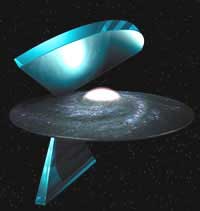Physics and Astronomy
This area deals with the fundamental laws and building blocks of nature and how they interact, the properties and the behavior of matter, and research into space and time and their structures.
innovations-report provides in-depth reports and articles on subjects such as astrophysics, laser technologies, nuclear, quantum, particle and solid-state physics, nanotechnologies, planetary research and findings (Mars, Venus) and developments related to the Hubble Telescope.

Interstellar searchlights catch star factories in their beams
Jets of particles from newly formed stars are acting like searchlights, piercing the gloom of dark interstellar clouds to pick out clumps of gas that may become future stars. Astronomers at University College London (UCL) and the University of Barcelona have discovered how these interstellar beams mark the clumps with a distinctive chemical signature, which makes them detectable with radio telescopes. These new developments in understanding how and where new stars are created will be discussed by Dr

Astronomers weigh neutrinos with the universe
Neutrinos, the lightest of the known elementary particles, weigh a billionth (one part in a thousand million) of a hydrogen atom at most, and can account for no more than one-fifth of the dark matter in the Universe, according to findings by astronomers in Cambridge, who used data from the Anglo-Australian telescope 2dF Galaxy Redshift Survey (2dFGRS). The results will be presented by Dr Ofer Lahav of Cambridge University at the UK National Astronomy Meeting in Bristol on Wednesday 10 April.

Astronomers detect stellar ashes at dawn of time
Using a powerful instrument on a telescope in Hawaii, UK astronomers have found ashes from a generation of stars that died over 10 billion years ago. This is the first time that the tell-tale cosmic dust has been detected at such an early stage in the evolution of the universe.
Dr. Kate Isaak of Cambridge University will be announcing these exciting new results at the National Astronomy Meeting in Bristol on 11th April 2002.
Using the SCUBA (Submillimetre Common-User Bolometer Arra

Neutrino weighed up
Astronomers use galaxies to reckon a subatomic particle’s mass.
By mapping hundreds of thousands of galaxies, astronomers have estimated the mass of the neutrino. They have also calculated the contribution that this mysterious subatomic particle makes to the total mass of the Universe.
The neutrino weighs no more than one-billionth of the mass of a hydrogen atom, Ofer Lahav of the University of Cambridge told the annual UK National Astronomy Meeting in Bristol today. Yet

Quark star glimmers
Astronomers may have discovered a strange new form of matter.
Astronomers think they might have spotted a quark star, a mass of fundamental particles only a few kilometres across but weighing more than our Sun. If the star’s nature is confirmed, it would be the first example of this state of matter.
Theoreticians hypothesized the existence of quark stars in the 1980s. Today, NASA announced the discovery of such a star, based on results from their space telescope the Chandra

Bringing space down to Earth to explain how stars form
In a laboratory in Nottingham, scientists are now creating the uniquely harsh conditions encountered in interstellar space. In an environment where the pressure is only one ten billion billionth (one part in 10 to the power 13) of atmospheric pressure, and the temperature a mere 10 degrees above absolute zero, Dr Martin McCoustra and his colleagues are able to mimic the surfaces of the ice-coated dust grains in interstellar clouds and to study the complex chemical and physical processes that take pla